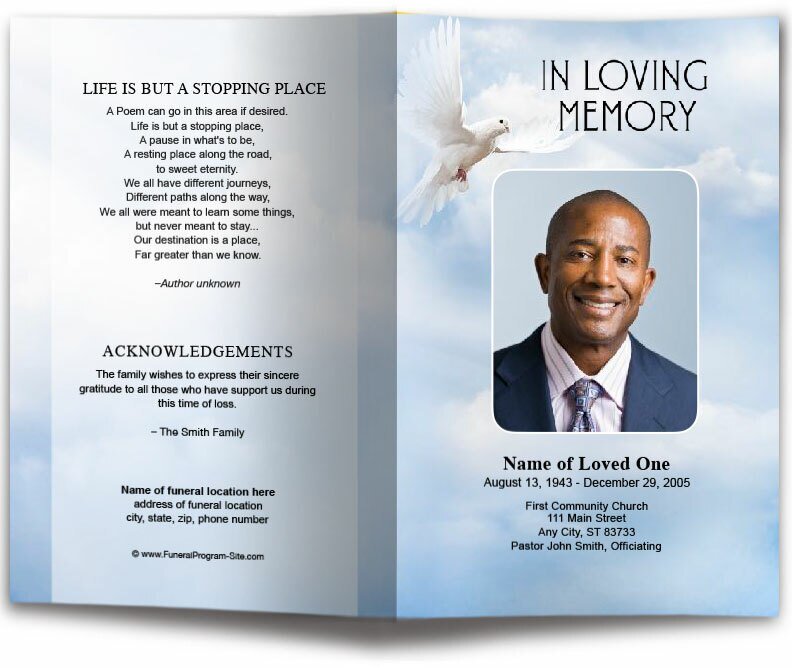What is Usually in a Funeral Program?

A funeral program is an important part of a funeral or memorial service. It serves as a guide for attendees, outlining the order of events and providing details about the person being honored. Funeral programs are often kept as keepsakes by family and friends, as they capture the essence of the service and provide a lasting tribute to the deceased. Below are the common elements usually found in a funeral program.
1. Funeral Program Cover Page
The cover of a funeral program typically includes basic information about the deceased and the service. It often features a photo of the individual and sets the tone for the rest of the program. Common elements on the cover page include:
- Full Name of the Deceased: The name of the person being honored is usually displayed prominently.
- Birth and Death Dates: These dates provide a timeline of the person's life.
- Photo: A photograph of the deceased is typically placed on the cover. This may be a formal portrait or a candid photo that reflects their personality.
- Service Information: The date, time, and location of the funeral or memorial service are also included on the cover page.
2. Order of Service
The order of service provides a detailed outline of how the funeral or memorial service will proceed. It typically lists each segment of the service, along with the name of the person leading or participating in that portion. The order of service may include:
- Opening Words: These may be spoken by a clergy member, celebrant, or family member to welcome attendees and set the tone.
- Scripture Readings or Prayers: If the service is religious, there may be scripture readings or prayers included.
- Hymns or Songs: Music often plays a central role in funeral services. The program will list any hymns, songs, or instrumental pieces performed during the service.
- Eulogy: The name of the person delivering the eulogy or multiple speakers may be included.
- Poems or Readings: If poetry, quotes, or other readings are part of the service, they may be mentioned here.
- Final Words or Benediction: The conclusion of the service, often led by a religious leader or celebrant.
3. Obituary or Life Story
Many funeral programs include an obituary or a brief biography of the deceased. This section provides an overview of their life, achievements, and the legacy they leave behind. Common elements in the obituary include:
- Personal Information: Details about their family, education, career, and hobbies.
- Milestones: Important events such as marriage, the birth of children, or significant accomplishments.
- Surviving Family: A list of surviving relatives, such as spouses, children, grandchildren, and siblings.
4. Photo Collage or Memory Section
Some programs include a photo collage or a section dedicated to sharing memories of the deceased. This may include images from various stages of their life, such as childhood, family events, vacations, and special occasions. This section allows attendees to reflect on the life and memories shared with the deceased.
5. Acknowledgments and Thank Yous
This section is often used to thank those who have provided support during the time of loss. It may include acknowledgments to family members, friends, caregivers, or medical professionals. The family may also thank the attendees for their presence and support. If the family wishes to direct donations in lieu of flowers, they may include this information here, such as:
- "The family would like to thank everyone for their love and support during this difficult time."
- "In lieu of flowers, donations can be made to [Charity Name] in [Deceased’s Name]’s honor."
6. Closing Page
The closing page may include a final quote, poem, or religious passage that reflects the spirit of the deceased. Some families choose to include a favorite saying, a scripture verse, or a few words of comfort to conclude the program. It may also reiterate the family’s gratitude to attendees for their support.
Conclusion: Creating a Meaningful Funeral Program
A funeral program serves as a guide and a keepsake for attendees, helping them follow along with the service while honoring the life of the deceased. By including important details such as the order of service, a life story, photos, and acknowledgments, the program provides a meaningful tribute that captures the essence of the person being remembered. Whether simple or elaborate, a thoughtfully designed funeral program helps create a lasting memory for all who attend.
© The Funeral Program Site ~ Funeral Program Templates and Cancer Ribbons





























